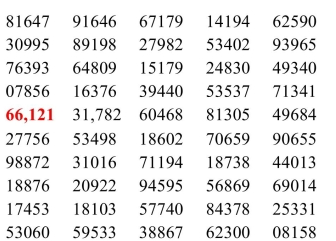Five-digit random numbers are used to simulate scores on each hole in an 18-hole round c The correspondence between the random numbers and scores on each hole is chosen to bc follows.
Use the following portion of a random numbers table starting with the highlighted numbe and determine how many holes the simulated golfer made par or better (i.e., how many holes-in-one, eagles, birdies, and pars were obtained in the 18 holes) . Use the highlightec as the score on the first hole; work down a column moving from left to right, column to : needed.
olf. number
Lumn as
A) 13
B) 10
C) 12
D) 11
Correct Answer:
Verified
Q39: The PAC-10 Conference consists of ten
Q40: A pollster wanted to determine how much
Q41: A bin at the store is
Q42: A researcher is using a random numbers
Q43: The basic simulation technique using random numbers
Q45: In many women's tennis matches they
Q46: In a free-throw relay, one member
Q47: A particular baseball player gets, on average,
Q48: Five students were scheduled to take
Q49: Simulate ten coin tosses using the following
Unlock this Answer For Free Now!
View this answer and more for free by performing one of the following actions

Scan the QR code to install the App and get 2 free unlocks

Unlock quizzes for free by uploading documents